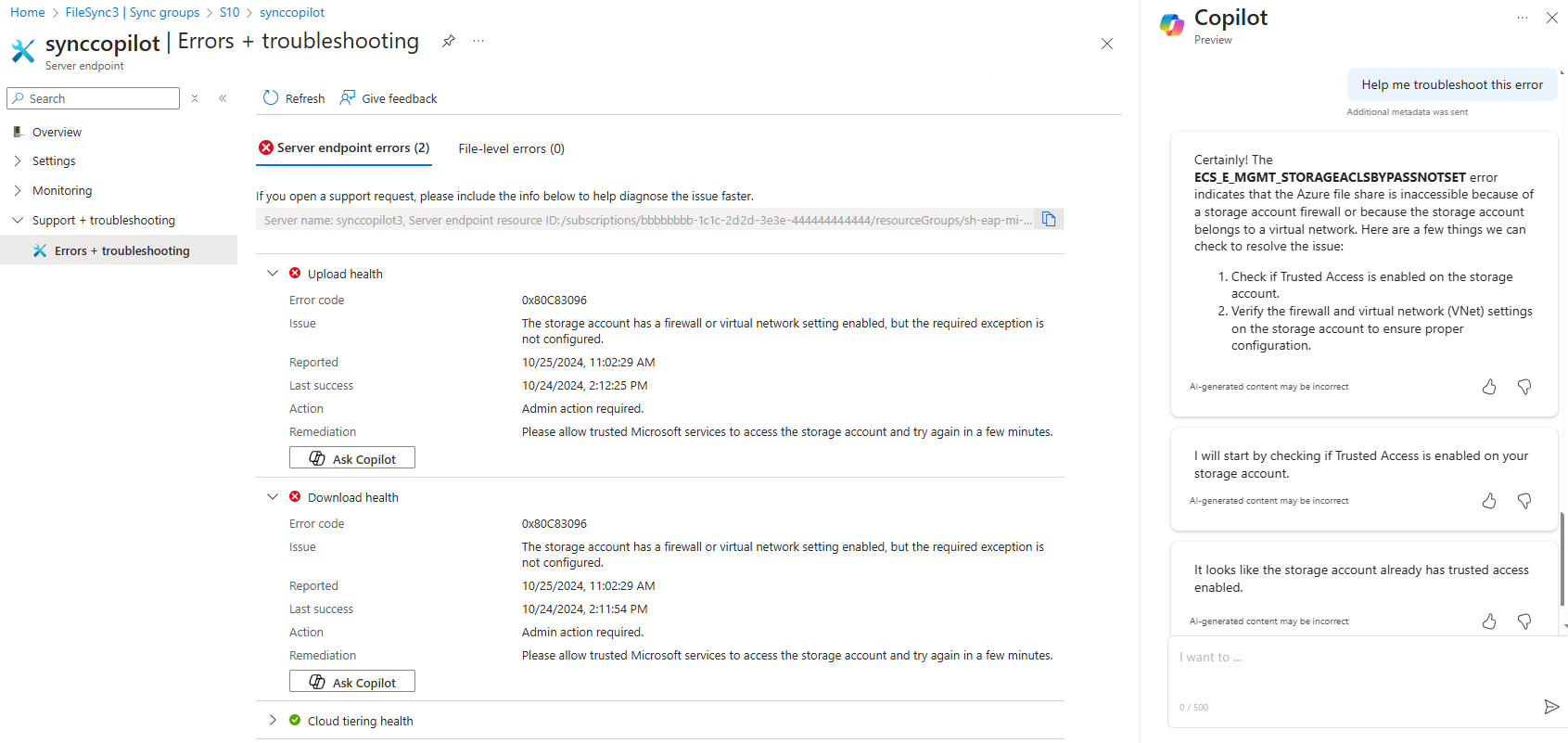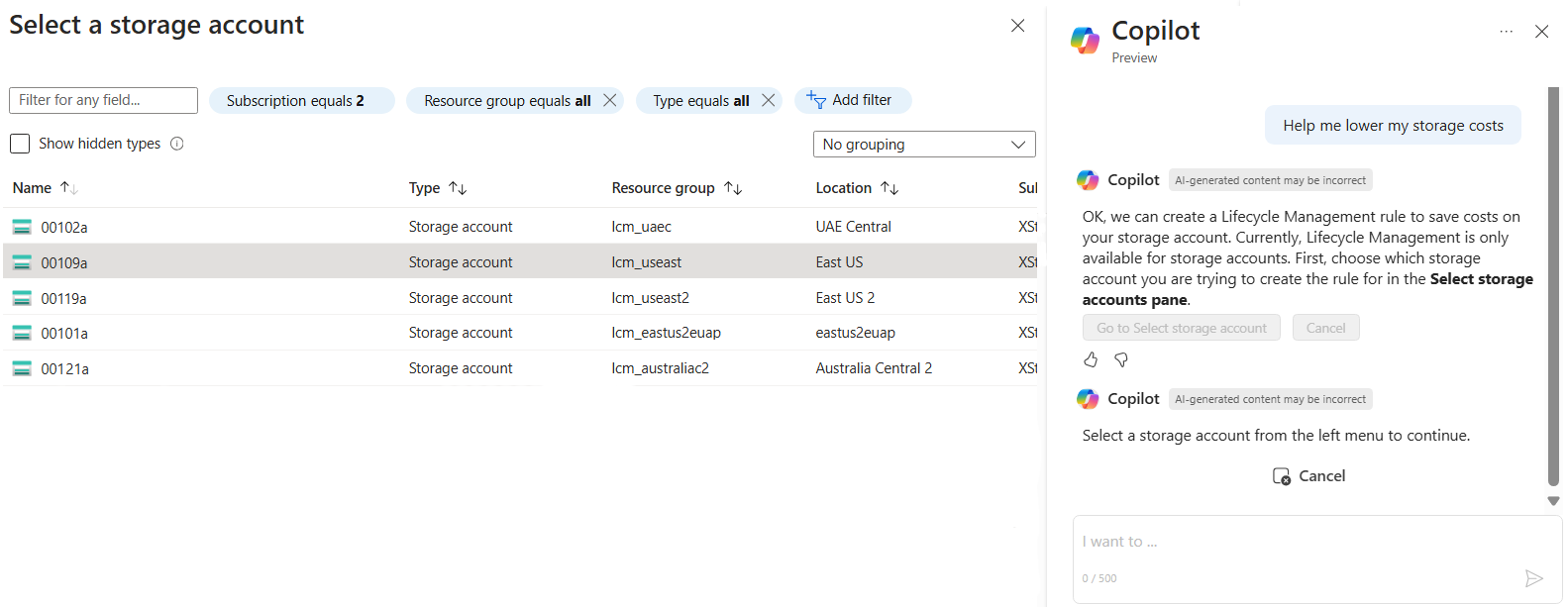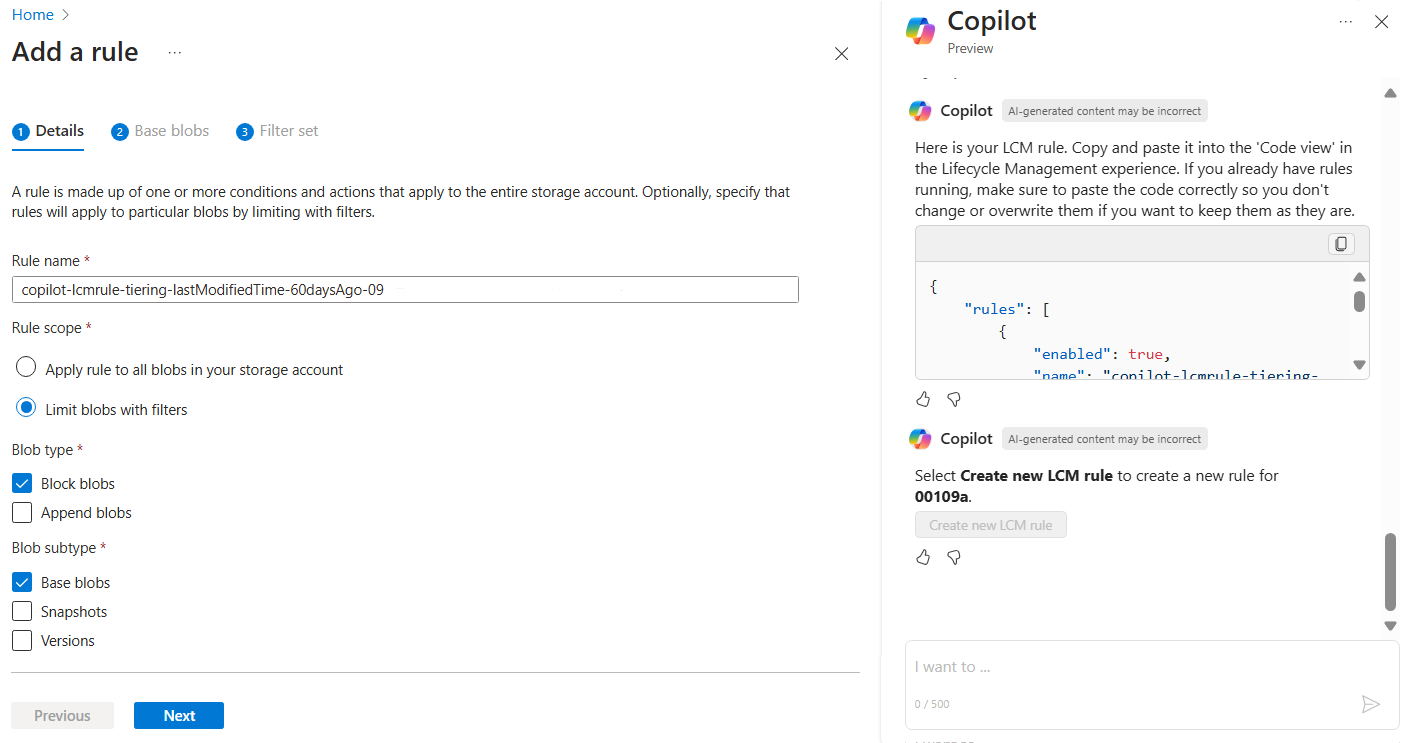Manage and improve storage accounts using Microsoft Copilot in Azure
Microsoft Copilot in Azure (preview) can provide contextual and dynamic responses to harden the security posture and enhance data resiliency of storage accounts. It can also help you troubleshoot and resolve common Azure File Sync issues related to your stored data.
Responses are dynamic and based on your specific storage account and settings. Based on your prompts, Microsoft Copilot in Azure provides specific recommendations to improve your storage account or resolve issues.
When you ask Microsoft Copilot in Azure about storage accounts, it automatically pulls context when possible, based on the current conversation or on the page you're viewing in the Azure portal. If the context isn't clear, you'll be prompted to specify the storage resource for which you want information.
Tip
The tasks and sample prompts listed here show a few of the areas where Microsoft Copilot in Azure (preview) can be especially helpful. However, this isn't a complete list of all the things you can do. We encourage you to experiment with your own prompts and see how Microsoft Copilot in Azure (preview) can help you manage your Azure resources and environment.
Important
Microsoft Copilot in Azure (preview) is currently in PREVIEW. See the Supplemental Terms of Use for Microsoft Azure Previews for legal terms that apply to Azure features that are in beta, preview, or otherwise not yet released into general availability.
Improve security
You can ask Copilot in Azure to help you improve the security of your storage account. Based on your prompts, Copilot in Azure runs a security check and provides specific recommendations to improve your storage account.
Security sample prompts
Here are a few examples of the kinds of prompts you can use to improve your storage account's security. Modify these prompts based on your real-life scenarios, or try additional prompts to get advice on specific areas.
- "How can I make this storage account more secure?"
- "Does this storage account follow security best practices?"
- "Is this storage account vulnerable?"
- "Prevent malicious users from accessing this storage account."
Security example
You can ask "How can I make this storage account more secure?" If you're already working with a storage account, Microsoft Copilot in Azure asks if you'd like to run a security check on that resource. If it's not clear which storage account you're asking about, you'll be prompted to select one. After the check, you'll see specific recommendations about things you can do to align your storage account with security best practices.
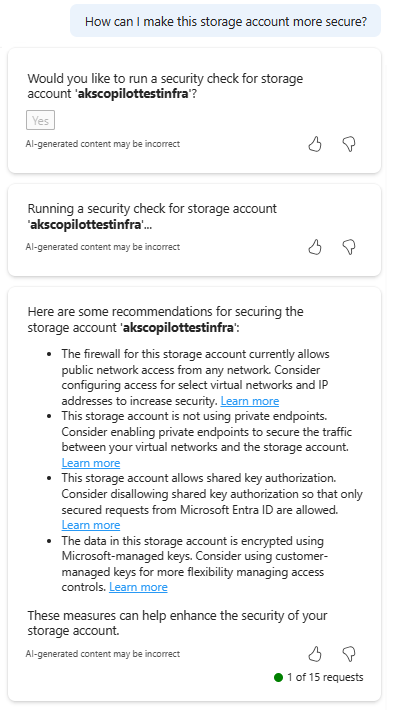
Enhance data resiliency
You can ask Copilot in Azure questions about enhancing your storage account's data resiliency. Copilot in Azure runs a data resiliency check and lets you know how you can help protect your storage account's data.
Data resiliency sample prompts
Here are a few examples of the kinds of prompts you can use to improve your storage account's data resiliency. Modify these prompts based on your real-life scenarios, or try additional prompts to get advice on specific areas.
- "Prevent this storage account from data loss."
- "How can I prevent this storage account from being deleted?"
- "How do I protect this storage account's data from data loss or theft?"
Data resiliency example
You can say things like "Prevent this storage account from data loss during a disaster recovery situation." After confirming you'd like Microsoft Copilot in Azure to run a data resiliency check, you'll see specific recommendations for protecting its data.
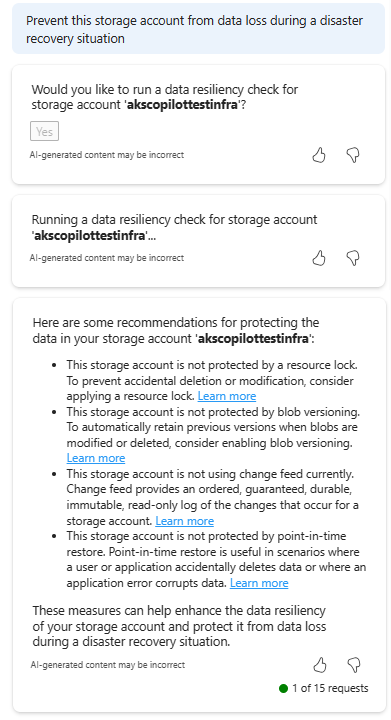
Troubleshoot and resolve Azure File Sync issues
If you use Azure File Sync, Copilot in Azure can help you quickly troubleshoot and resolve common issues. It analyzes your environment to identify potential root causes, such as network issues, incorrect permissions, or missing file shares. After that, Copilot in Azure provides actionable recommendations.
Azure File Sync sample prompts
Here are a few examples of the kinds of prompts you can use to help diagnose and fix your Azure File Sync environment. Modify these prompts based on your real-life scenarios, or try additional prompts to get advice on specific areas.
Troubleshooting specific error codes:
- "Help me troubleshoot error code 0x80C8305F."
- "Help me troubleshoot error code 0x80C83096."
Permissions and network configuration:
- "Do I have correct permissions to access the file share?"
- "Is my network configured correctly to access the file share?"
General troubleshooting:
- "How do I fix my Azure File Sync environment that stopped syncing?"
- "Help me fix sync errors in my AFS environment."
- "How do I fix a server that has a state of 'appears offline'?"
- "Help me diagnose issues with my Azure File Sync environment."
Azure File Sync example
If you see an error code, you can ask Copilot in Azure to help you understand the problem and how to fix it. When you say "Help me troubleshoot this error", Copilot in Azure provides information about the error and the things that Copilot in Azure can check to help resolve the issue. In this example, Copilot in Azure first checks to see if trusted access is enabled on the storage account.
After confirming that trusted access is enabled, Copilot in Azure prompts you to enter the server IP address that should be able to access the storage account.
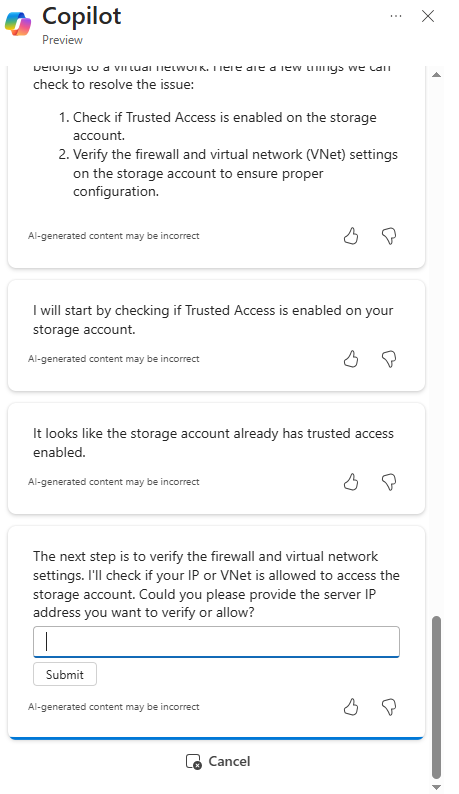
Copilot in Azure then checks to see if that IP address is currently able to access the storage account. If it isn't, Copilot in Azure asks if you want it to update your settings to allow access. If you prefer, you can update the firewall yourself, or ask Copilot to share more details.
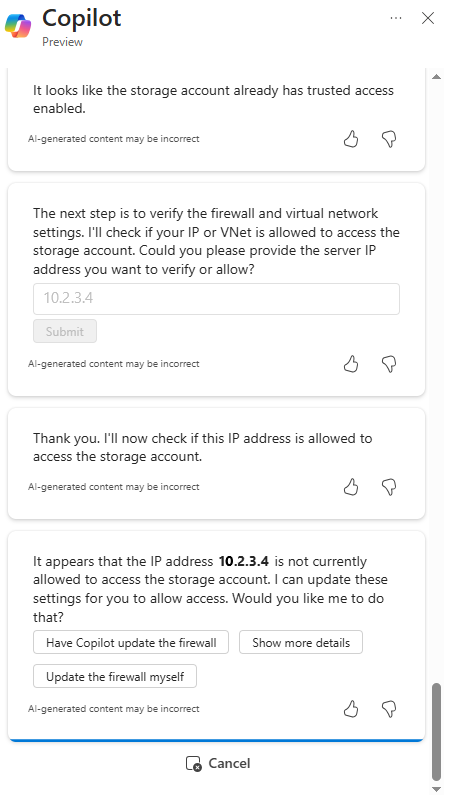
When you ask Copilot in Azure to update the firewall for you, it proceeds to add the IP address you entered to the allowlist in the storage account's firewall settings.
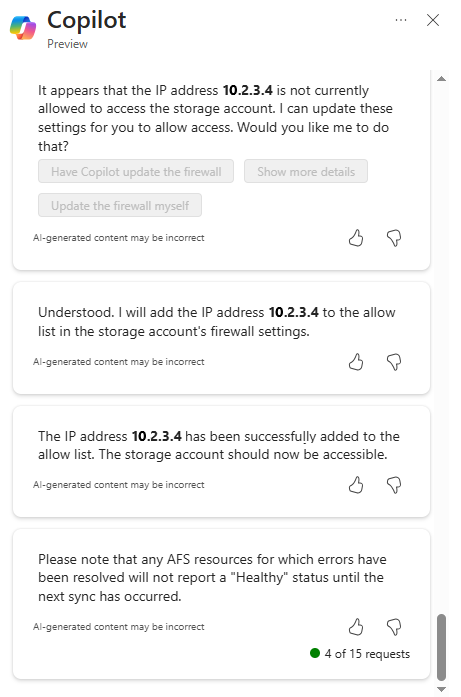
Reduce storage costs
You can ask Copilot in Azure to help you manage the costs for your storage accounts. One way to save on storage costs is by tiering blobs that haven't been accessed or modified for some time. In some instances, you may even wish to delete those blobs.
When you ask Copilot in Azure about reducing your storage costs, it provides suggestions and helps you accomplish bulk tiering by automating lifecycle management rule authoring.
Storage cost reduction sample prompts
- "How can I save costs on my storage?"
- "Help me save costs on my storage"
- "I want to reduce the costs of my storage account"
- "Help me reduce the costs of my storage account"
- "I want to reduce the amount I am paying in storage"
- "Help me reduce the amount I’m paying in storage"
- "Help me write an LCM rule for my storage account"
- "I want to create an LCM rule for my storage account"
- "Create an LCM rule for my storage account"
- "Help me create an LCM rule for my storage account."
Storage cost reduction example
If you say "Help me lower my storage costs", Copilot in Azure will begin the lifecycle management rule creation process.
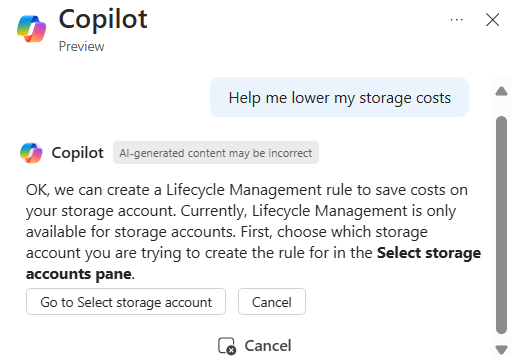
First, Copilot in Azure prompts you to select the storage account that you want to work with.
After you select a storage account, Copilot in Azure asks which action you want to create a rule for: tiering down, or deleting stale data. Next, you define a condition on which to trigger the rule.
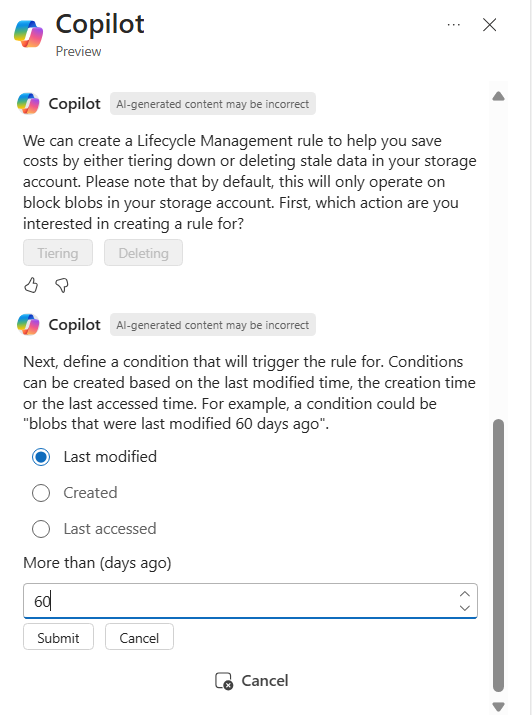
Finally, Copilot in Azure asks you whether you want the rule to run on the entire account, or only on a subset of the account. In this example, the rule will only run on a subset of the account, defined by a blob prefix.
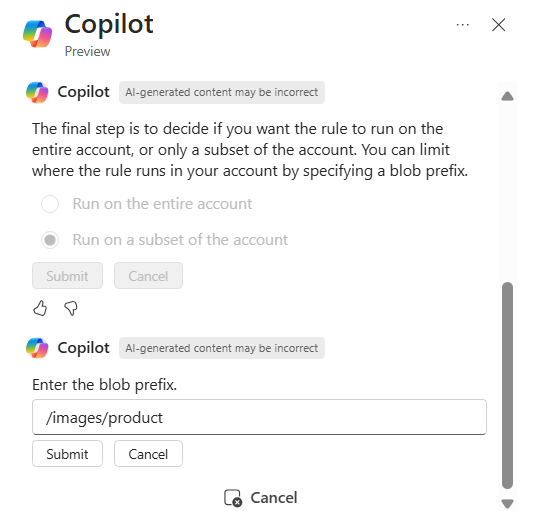
Now that Copilot in Azure has all of the necessary information, it creates the lifecycle management rule.
You can copy and paste the rule yourself, or have Copilot in Azure apply the rule for you. After the rule has been applied successfully, you'll see a confirmation.
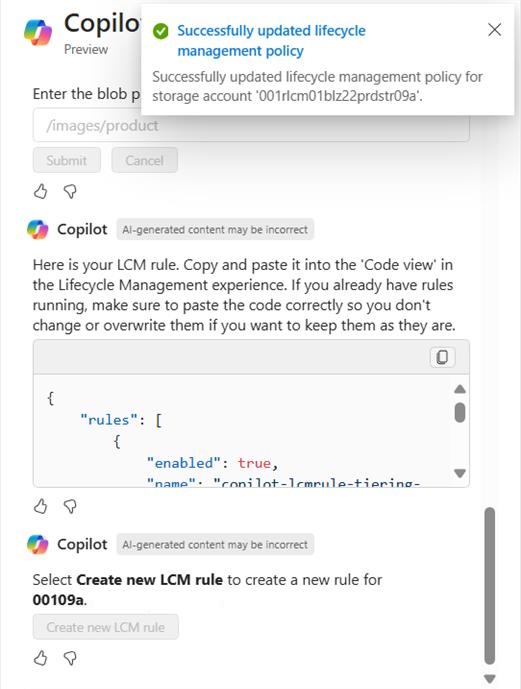
Next steps
- Explore capabilities of Microsoft Copilot in Azure.
- Learn more about Azure Storage.
